Can't Afford To Buy Things For Your Garden?
Can't afford to buy things for your garden?
*Re-posting, with new information
A store-bought bag of topsoil, a roll of landscaping fabric, or a bag of cedar chips doesn’t go very far if you have a large garden or a very limited budget. Here are some ways to create the materials you need for a beautiful, organic, productive garden, by both re-directing household waste, and foraging in your local area. I use a lot of these tricks in my garden to make it almost completely free for me to continue growing new things, and expanding the workable area every year!
For soil
Save your food scraps to create a rich compost for growing veggies and amending your soil. There are numerous options for every size of dwelling and yard. Small space solutions such as Bokashi and vermicompost work indoors and don’t produce bad smells, so you can keep them underneath the sink.Worm towers, compost heaps, and outdoor compost bins are a great solution if you have more space. The more you add, the more rich, nutritious material you can make for your garden. I like composting because it means I don’t have gross smelly garbage bags to deal with, because food waste is diverted. It seems like a lot of work at first, but it actually saves time, money, and transportation.
Seaweed or kelp is one of the best things for your garden, with over 70 essential nutrients, and acting as a weed barrier and a moisture-retentive mulch. I collect seaweed nearby on the beach with my bike trailer, or, when I go for a walk I bring a little home with me each time. It’s an absolute miracle for your soil.

Worm tower
Fertiliser
There are three things that are essential for plant growth. These are nitrogen for leaves and vegetation (N), phosphorus for roots and shoots (P), and potassium for water movement, flowering, and fruiting (K). Commercial fertilisers will give the relative concentrations of each of these compounds with and “NPK” rating. Plants like tomatoes also need calcium to produce healthy fruit. You can create amendments for your garden and soil at home so that you do not have to purchase fertiliser.
For nitrogen
Grass clippings contain 4% nitrogen, 1% phosphorus, and 2% potassium (NPK = 4-1-2).
Human urine contains 12% nitrogen, and it’s sterile. Dilute before adding directly to plants.
Legumes such as beans, clover, peanuts, and alfalfa fix inorganic nitrogen into the soil with mycorrhizal organisms and nodules on their root systems. Plant these crops every few years in rotation with others to renew the soil organically.
For phosphorus
Human urine is also a great source of phosphorous and trace amounts of potassium.
Ground up bones or shells add a slow-release phosphorous to the soil
Had a baby recently? Bury the placenta in the garden.
For potassium
Hardwood ashes
Composted banana peels
For calcium
Break down all of your eggshells, or seashells you have found, in a plastic bucket, using vinegar. This creates a soluble calcium solution you can add to a watering can.
Soil Acidity/Alkalinity
Many plants are particular about what the soil pH should be.
To make soil more acidic: add oak leaves, pine needles, leaf mulch, urine, coffee grounds or sphagnum.
To make soil more alkaline: add wood ash, shell, or bone.
Mulch
Mulch is decomposing organic matter that adds nutrition to the soil, while simultaneously keeping out weed growth and retaining moisture. It also attracts worms, fungi and other beneficial creatures to your soil. Free sources of mulch include:
Leaves
Garden waste
Grass clippings
Straw (often straw bales are given away after being used for decoration in the fall. You can also plant vegetables directly in straw bales using a technique called straw bale gardening).
Wood chips (if you can borrow a wood chipper after you’ve collected some wood you can have attractive wood mulch for free)

Straw bale garden
Landscaping fabric
When mulch isn’t enough to keep the weeds down, many people opt for landscaping fabric. It can be quite expensive and inorganic-looking. Free solutions that both attract worms and can be replaced in small segments as they break down include:
Newspaper*
Cardboard*
Egg cartons*
Printer paper, looseleaf, etc. in thick layers*
*try to make sure you are using paper that has vegetable-based dyes, so you aren’t leeching toxins into the soil.
Soil density/drainage
If your soil is compacted and you have plants that require low levels of water, or excellent drainage, add sand. I don’t recommend stealing it from the beach, but ask around and you’d be surprised at how easy it is to get for free. Sawdust also improves drainage. Adding organic matter and mulch encourages worms, who also till and aerate compacted soil.
If the area still needs drainage, dig a hole and fill it with bricks or rocks to create a “dry well”
For drainage in pots, add crushed bricks, terra cotta pot fragments, packing peanuts, small stones, marbles, orsand to the bottom under the soil layer. I find these in construction sites, on craigslist, or at flea markets.
Pots and growing containers
If you have space, raised beds are a great no-dig way to establish growing space. If you are pressed for space (like working on a balcony) there are many cheap or free options for container gardens.
Creating raised beds allows you to build up the soil without digging. Free ways to do this include using rocks or lumber (like my DIY “lasagna garden” made with the sheet composting technique), using the “wattle“ method with sticks and posts you have found, using discarded straw bales, old bricks,paving stones, cinder blocks or really anything else you have lying around.
Hugelkutur raised beds, which fix carbon and provide drainage, can be made by stacking sticks and untreated wood, and then piling soil or compost over it. (Thanks milos-garden)
Rubber tire gardens retain heat in the night and allow for great drainage. They can also be painted in fun ways.
Herb spirals (here is mine: 1, 2, 3) can be built with stones, bricks, and other found materials.
I often use old cooking pots, barbecues, teapots, or other found objects as planters.
Making wooden planters is easy, and scrap or salvaged wood is also easy to come by. I’m not a fan of using wooden pallets for DIY projects, but they are also a free source of lumber for things like planters.
If you can track down peat moss, cement, and vermiculite, you can make an easy Hypertufa planter in whatever shape you would like, provided you have a form in which it can dry.
I’ve made hanging gardens out of soda cans.
You can build a self-watering container with a 2L pop bottle.
Start seeds in eggshells
Make biodegradable pots out of newspapers.
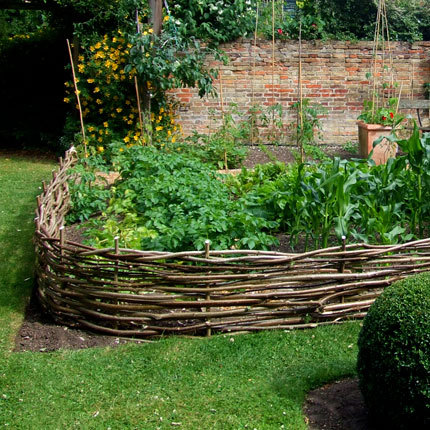
Wattle raised beds

Rubber tire gardens

Hugelkultur

An herb spiral
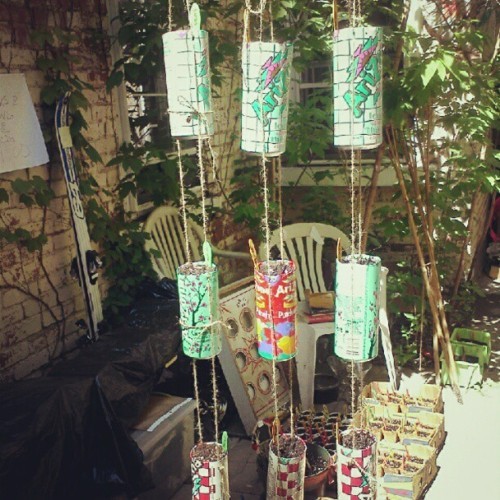
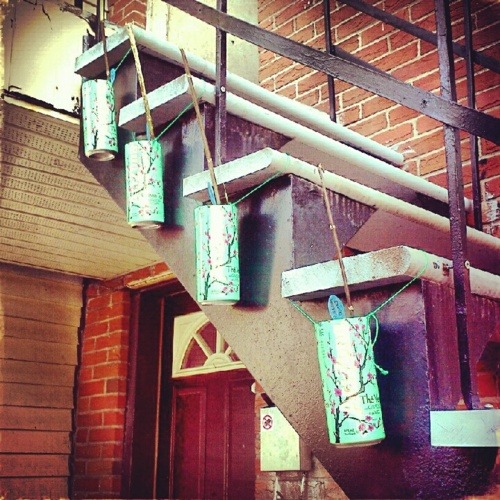
Hanging gardens in cans (2)
Trellises and supports
Many plants need external support, such as stakes of trellises, to thrive.
Rebar can almost always be salvaged cheaply or free and makes a great trellis, arch, or purgola
Build trellises and supports out of the pliable young stems of plants like willow
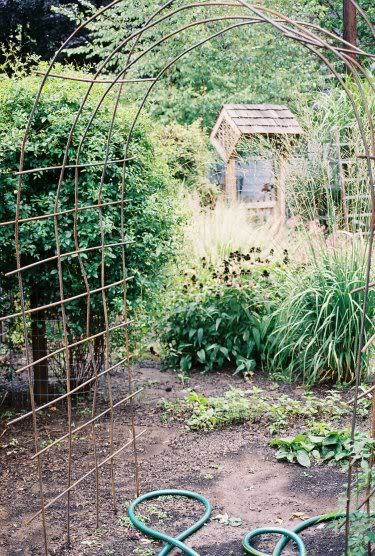
Rebar trellis/arch

Living willow arch/trellis
Paving
Paving often requires a foundation of sand or another stable and well-drained substrate, and a covering of stones, bricks, or other weatherproof elements. Slowly collect stones over time, or free paving stone fragments to create a mosaic-type walkway. Often people give these things away on craigslist. I made a patio and fireplace out of free salvaged bricks, for example.

Salvaged garden walkway
Greenhouses and cold frames
Here is a gallery of greenhouses made out of salvaged windows and doors
A cold frame is easy to make with salvaged lumber, and plastic sheeting.
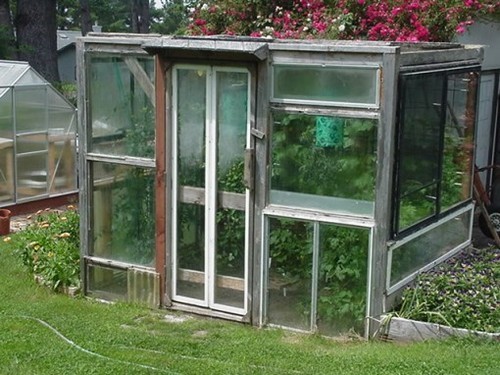
Window greenhouse
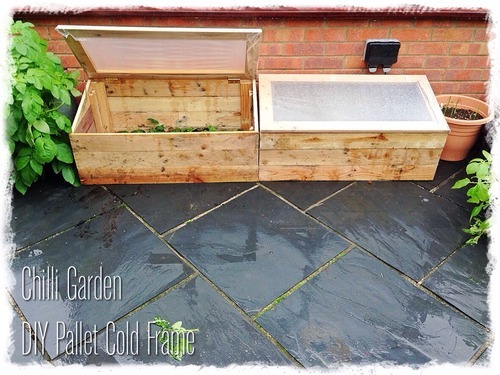
Palet cold-frame
Seeds and plants
Swap seeds with other gardeners
If you see a plant you like at someone’s house, ask for seeds or cuttings
Save seeds every year and build a library of options. Here is a great guide to seed saving.
Save seeds from foods you like from the grocery store: consider growing peanuts, ginger, garlic, peppers, or a walnut tree: all of these and more can be planted from store-bought produce.
Learn to take cuttings. There is a tonne of info on the web about basic cutting propagation, layering, (like I do with rhododendrons) air layering, and numerous other techniques to take clones of plants you like. This saves going to a nursery and shelling out big bucks for all the variety you want.
For cuttings, willow tea and honey are great rooting hormones/antiseptics/anti-fungal agents, which can save you $40 if you were thinking of buying commercial rooting hormone.
You can root cuttings in a potato! (See my methods for rooting “borrowed” plants here)
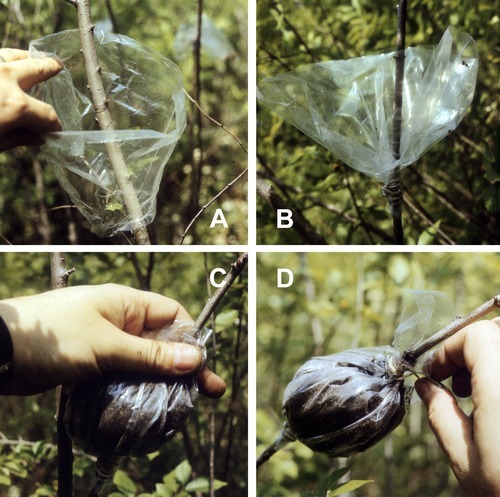
Air layering
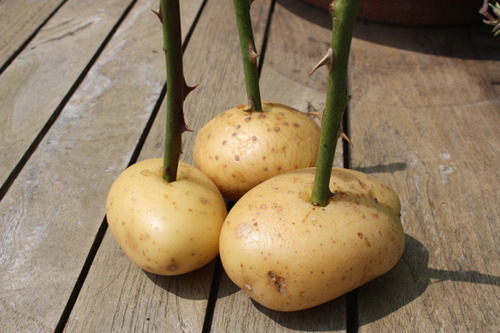
Rooting cuttings in potatoes
—-
I hope this helps you build your garden outside of the usual capitalist channels! It can be a cheap or free hobby if you are willing to think outside the box, and maybe put up with things that don’t look as clean or crisp as a hardware store catalogue. If you have any further ideas, please add them! The more information the better.
More Posts from Green-notebooks and Others

FTA: “Kenya installs the first solar plant that transforms ocean water into drinking water, and it could be the solution to the global lack of water
The Earth is a watery place. In fact, 71 percent of our planet is covered in water [1]. Despite this, one in nine people do not have access to safe drinking water – that’s around 785 million people [2].
The trouble is, 96.5 percent of all Earth’s water is found in the oceans in the form of saline water, and is not drinkable for humans. That only leaves us with rivers, lakes, and groundwater to satisfy our water needs [1].
According to the World Economic Forum, the global water crisis ranks as the number four risk in terms of impact on society [3]. Let’s face it – humans need water to survive.
If you’re reading this from Canada or the United States, you may not understand this crisis on a personal level. After all, you can turn on a tap and have safe drinking water instantly start flowing from the faucet. This, however, is not the case for billions of people living on other continents. One NGO (Non-Government Organization) is trying to change that.
GivePower
Give Power’s mission is to install solar energy technologies that will bring essential services to developing communities in need [4]. Their most recent break-through project installed a solar-powered desalination system to bring clean, healthy water to the people in Kiunga, a rural village in Kenya [4].
With this technology, the salty ocean water will now be a viable source of water for the people living in this village. The system is capable of producing about 70 thousand litres or drinkable water every day, which is enough for up to 35 thousand people [4].”
GivePower
Do note that they are not yet rated on Charity Navigator

Want to know how you can be a part of the solution in fighting and defeating climate change?
TED-Ed has partnered with the United Nations to make a 30 day challenge to teach you everything you need to know about the climate, the environment and much more (this comes in handy in debates, talks with people that aren't aware of why we should protect the Earth, in knowing what to ask the governments when protesting and many more situations). Knowledge is power and power is what we need if we want to achieve our goals.
They already got to day 13 but the videos are short so you can catch up by watching a few a day. Enjoy!

no, listen, when I say I want to integrate more specific solarpunk stuff in my life, i don’t mean to ask for yet again new “aesthetic” clothes that now you have to buy or make to show your support of the movement (screw that i’m consuming enough as it is), or more posts about impossible house goals, or whatever, I’m asking you what my options to build a portable and eco friendly phone charger are, im asking you viable tiny-appartment edible plants growing tricks on a budget, im asking tips to slow down when my mind and society tell me im not fast enough, i don’t need more rich art nouveau amateurs aesthetics or pristine but cold venus project, okay, i know i should joins associations where I am tho i’m constantly on the move, thanks for that, just, you know, can we get a bit more practical ??? how do I hack my temporary flat into going off the grid for the time i’m here

Those “clean energy is ready to go whenever” memes annoy the hell out of me because they’re typically ignoring two-thirds of the issue.
In a nutshell, there are three legs of energy infrastructure:
Power generation: Getting the power in a useful form
Power transport: Getting the power in a useful form where you need it
Power storage: Getting the power in a useful form when you need it
In some respects, clean power generation is, indeed, a solved problem; clean transport and storage, however, are not. For many applications, no good non-polluting alternatives exist, and when they do, the environmental costs of setting up and maintaining those alternatives are not, themselves, insignificant. (Look up what goes into your average rechargeable battery some time!)
No, that doesn’t mean it’s an impossible problem, nor does it in any way excuse the continued intransigence of the the petrochemical industry. It does mean that there’s still a great deal of important work to be done, and it’s galling that so many self-labelled environmentalists are just casually contemptuous of it all - often to the extent of accusing researchers in power transport and storage of being oil industry shills for having the temerity to discuss the remaining challenges - because “clean energy is ready to go whenever”.

This is literally WALL-E lmfao





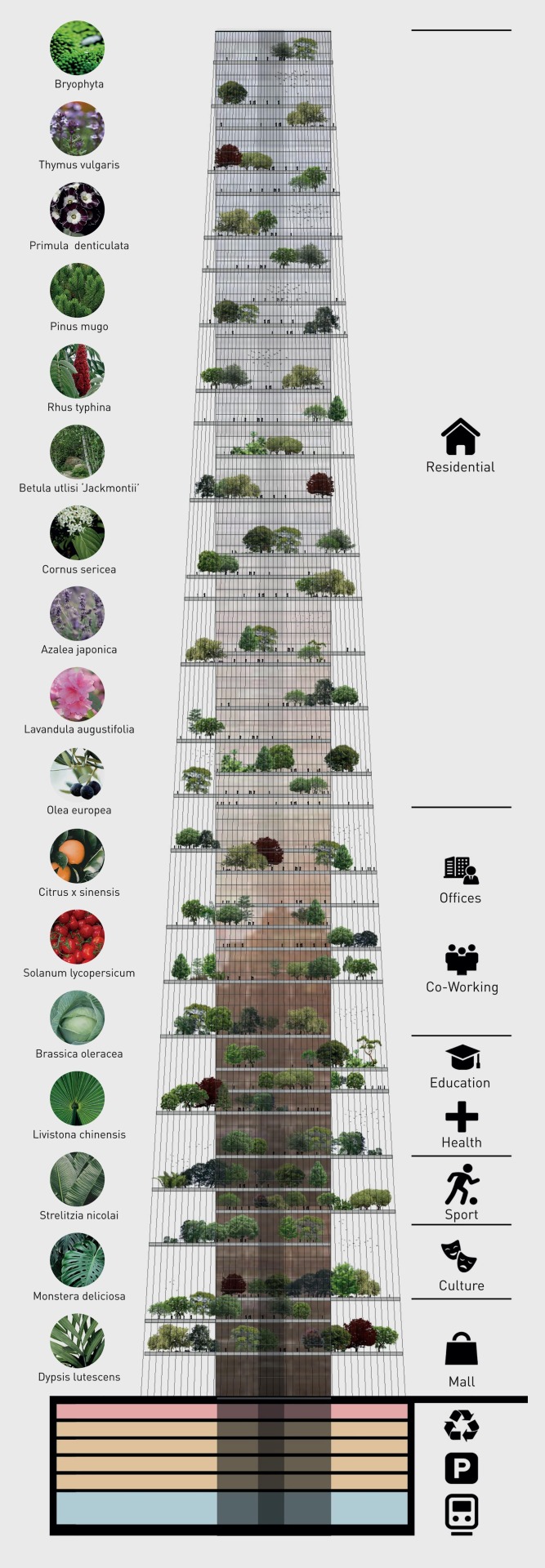



‘Skylines,’ New York, United States,
Lissoni Casal Ribeiro for Skyhive 2020 skycraper Challenge
Inspired by nature, the concept proposes a complete, self-sufficient ecosystem. the multi-use tower collects rainwater and gathers energy from the sun and the wind, transforming it from its tensioned cables into electricity to be used by inhabitants.
Basic Homesteading Skills
Crafts
quilting
embroidery
cross-stitch
knitting
crochet
sewing
Cooking and Baking
homemade bread
homemade butter
homemade extracts
dandelion jelly
Canning
26 canning recipes
canning jars 101
60 canning recipes
Gardening
edible trees to plant
what to plant to save the bees
cure and braid garlic
save seeds for next year
braid onions for long term storage
build a greenhouse
Animals
homemade chicken feed
raising mealworms for chickens
why to raise nigerian dwarf goats
Outdoors
starting a fire with sticks
trail signs
knotting
find true north without a compass
Medicine
homemade neosporin
all purpose healing salve
You know what line gets me every time I watch MAD MAX FURY ROAD?
“Do not, my friends, become addicted to water. It will take hold of you, and you will resent its absence.”
Think about that. “Addicted to water.” It makes it sound like water is an extra luxury that people don’t need but are greedy for, something they should be able to go without, and if they are desperate for it, it’s their own fault, and not the fault of the man who has all of it, and withholds it.
Think about how the people in power tell us not to be greedy for the things we need, like healthcare, like a living wage, like the right to be free of fear and violence in our own communities. The people in power tell us not to be greedy for these things, when they themselves already enjoy them freely, and withhold them from us.
Don’t trust the narrative that tells us we’re being greedy by asking for things that we need.
Don’t trust the asshole sitting on a grassy hilltop with his hand on the spigot telling us not to be greedy for water.
-
 jernostrapig liked this · 1 week ago
jernostrapig liked this · 1 week ago -
 solskip reblogged this · 2 months ago
solskip reblogged this · 2 months ago -
 alliumlover reblogged this · 3 months ago
alliumlover reblogged this · 3 months ago -
 sylph-ofspace reblogged this · 3 months ago
sylph-ofspace reblogged this · 3 months ago -
 sylph-ofspace liked this · 3 months ago
sylph-ofspace liked this · 3 months ago -
 agenderautomaton reblogged this · 3 months ago
agenderautomaton reblogged this · 3 months ago -
 grimoirepromps reblogged this · 3 months ago
grimoirepromps reblogged this · 3 months ago -
 3lovelyroses reblogged this · 3 months ago
3lovelyroses reblogged this · 3 months ago -
 3lovelyroses liked this · 3 months ago
3lovelyroses liked this · 3 months ago -
 norsemythologie reblogged this · 3 months ago
norsemythologie reblogged this · 3 months ago -
 melaniekatewrites liked this · 3 months ago
melaniekatewrites liked this · 3 months ago -
 bambi-smiles reblogged this · 3 months ago
bambi-smiles reblogged this · 3 months ago -
 bambi-smiles liked this · 3 months ago
bambi-smiles liked this · 3 months ago -
 ladymadeleine liked this · 4 months ago
ladymadeleine liked this · 4 months ago -
 the-bogstomper reblogged this · 4 months ago
the-bogstomper reblogged this · 4 months ago -
 the-bogstomper reblogged this · 4 months ago
the-bogstomper reblogged this · 4 months ago -
 the-bogstomper liked this · 4 months ago
the-bogstomper liked this · 4 months ago -
 red-skady reblogged this · 4 months ago
red-skady reblogged this · 4 months ago -
 jademaster666 liked this · 4 months ago
jademaster666 liked this · 4 months ago -
 finder-of-things reblogged this · 4 months ago
finder-of-things reblogged this · 4 months ago -
 humanaagata liked this · 4 months ago
humanaagata liked this · 4 months ago -
 prin-cesspool-party reblogged this · 5 months ago
prin-cesspool-party reblogged this · 5 months ago -
 prin-cesspool-party liked this · 5 months ago
prin-cesspool-party liked this · 5 months ago -
 borderlinehannibal reblogged this · 5 months ago
borderlinehannibal reblogged this · 5 months ago -
 houndfather reblogged this · 5 months ago
houndfather reblogged this · 5 months ago -
 agentukelele reblogged this · 5 months ago
agentukelele reblogged this · 5 months ago -
 luxaii reblogged this · 5 months ago
luxaii reblogged this · 5 months ago -
 luxaii liked this · 5 months ago
luxaii liked this · 5 months ago -
 naturall--disaster liked this · 5 months ago
naturall--disaster liked this · 5 months ago -
 badluckducks liked this · 6 months ago
badluckducks liked this · 6 months ago -
 ouropod liked this · 6 months ago
ouropod liked this · 6 months ago -
 ouropod reblogged this · 6 months ago
ouropod reblogged this · 6 months ago -
 wanderer001 reblogged this · 7 months ago
wanderer001 reblogged this · 7 months ago -
 wanderer001 liked this · 7 months ago
wanderer001 liked this · 7 months ago -
 enigma-absolute reblogged this · 7 months ago
enigma-absolute reblogged this · 7 months ago -
 enigma-absolute liked this · 7 months ago
enigma-absolute liked this · 7 months ago -
 artimies6 reblogged this · 7 months ago
artimies6 reblogged this · 7 months ago -
 malaikame liked this · 7 months ago
malaikame liked this · 7 months ago -
 nightwingsparrow liked this · 8 months ago
nightwingsparrow liked this · 8 months ago -
 frostythelawfullchaotic reblogged this · 8 months ago
frostythelawfullchaotic reblogged this · 8 months ago -
 frostythelawfullchaotic liked this · 8 months ago
frostythelawfullchaotic liked this · 8 months ago -
 sh-nin liked this · 8 months ago
sh-nin liked this · 8 months ago -
 brbananas reblogged this · 8 months ago
brbananas reblogged this · 8 months ago -
 mentalrainbow liked this · 8 months ago
mentalrainbow liked this · 8 months ago -
 alicornairport liked this · 8 months ago
alicornairport liked this · 8 months ago -
 chirrychirrybangbang reblogged this · 8 months ago
chirrychirrybangbang reblogged this · 8 months ago -
 chirrychirrybangbang liked this · 8 months ago
chirrychirrybangbang liked this · 8 months ago